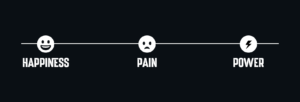It’s tough!
That’s the painted picture of a discovery call. But in reality, they are not as hard as they are made out to be.
The goal behind every discovery call is the same: to find out if the prospect is best suited to work with, learn more about them, and sell them your offer.
So why does discovery call work better for some than others?
It’s the structure of their discovery call or layout! You can call it whatever you want.
But the secret behind their discovery calls success is how they have structured it, and they stick to that structure no matter what the offer is, whether it’s $500 or $5000.
You need to layout your discovery call in a particular format and follow it consistently.
Over time, you’ll become so good at it that you’ll be able to close any discovery call you schedule.
So, how do you structure your discovery call?
Here is the discovery call structure I have followed for the past five years.
I have divided my discovery call structure into 5 stages, each of which plays a significant role in the success of the discovery call.
Stage 1: Introduction and Get Personal with the Prospect
Here, you introduce yourself and get to know your prospect on a personal level by asking specific questions that will get the prospect to open up and share more information that will help you.
Examples of a few questions:
- How have you been?
- What are some big wins you had recently?
- What’s your big goal?
Any personal questions that the client can answer quickly would help make them feel more comfortable on the call.
And that’s your goal here.
Stage 2: Qualifying The Prospect
I firmly believe that this phase is crucial in the discovery call because if you make a wrong judgment here, you might end up with the short end of the stick.
So in this stage, be attentive and listen carefully to every interaction.
Try to ask questions that will help you determine whether or not you are a good fit to work with the prospect.
- Tell me more about the project.
- Have you ever hired someone in the past to work on this project?
- What are the main problems you are facing currently?
- What’s going to be your biggest priority in this project?
- What does success look like to you for this project?
Ask any question that would give you an idea about whether you are a good fit for this project or not.
Stage 3: Present Your Solution, Your Offer
Once you get a good grasp of the project, you are ready to present your solution to them.
Here it would help if you tried to cover a few key things to make your offer awesome.
- What are you offering as a solution?
- How is it going to solve their problem?
- How the solution or offer will work (A general outline or Scope of work).
- How have you helped other clients with the same solution?
- How will they be updated with the work progress?
- How will you make them feel that they are involved throughout the project?
Stage 4: Get Them Talking Now
At this point, you have shared the complete picture of how you will help them and how it will be beneficial for them. The only thing left to do is get the prospect talking about the doubts, issues, or fears.
Ask questions or make it easier for the pros[ect to talk about their doubts and issues about your offers.
You can simply achieve this by asking specific questions.
- Is there anything you would like to ask about the offer or proposed solution?
- Do you have any questions you would like to ask?
- When’s the best time to start?
Don’t forget your goal in this stage, and that’s to make them comfortable and confident in your proposed solution.
Step 5: Let’s Talk About The Money
Now, this is where you reveal the price tag on your service and offer. But you can’t be very direct with it.
Based on all four stages of the call, you might already have an idea about the potential budget of the prospect.
All you need to do is present your offer with the cost you have thought about or the package you have.
Try to share the following details:
- Your Actual Pricing
- How can clients pay you?
- Do you want the full payment before the project or 50/50?
- Handle any potential payment ejection prospect can have.
- Be confident about your pricing, and don’t negotiate much.
If you follow the five stages I discussed above and cover all the topics I shared; then you’ll get the sell.
My Conclusion:
Discovery Calls isn’t just a call, it’s an experience, and it’s an opportunity to make a good impression.
Now, whether you succeed or fail at making an impression depends on how you deal with your discovery calls.
You can’t jump in any battle without preparation or a plan in hand.
The same can be said for a discovery call. You cannot hop on one without any preparation or plan.
That’s why I have shared my five-stage discovery call format to get more clients or conversions.
You can replicate it to get more success with discovery calls.
How do you deal with your discovery calls? What format or layout do you use to get better closings?






